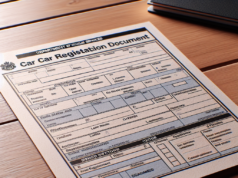Contents

Vermont Vehicle Registration: A Comprehensive Guide
If you own a vehicle in Vermont, you need to register it with the Vermont Agency of Transportation to comply with state laws. In this article, we provide a comprehensive guide to the process of registering your vehicle in Vermont.
Registration Requirements
The following vehicles require registration in Vermont:
– Passenger cars
– Trucks
– Motorcycles
– Trailers
– Recreational vehicles
– Boats
To register your vehicle, you will need:
– Proof of ownership (title or registration certificate)
– Vermont driver’s license or state-issued ID
– Vermont safety and emissions inspection certificate (if required for your vehicle)
– Vermont Tax Exemption Certificate (if applicable)
– Vermont Registration, Tax, and Title application
– Payment for registration fees and taxes
– Proof of insurance
Registration Process
Here is a step-by-step guide to registering your vehicle in Vermont:
1. Obtain a title for your vehicle.
If your vehicle is new or was previously titled in another state, you’ll need to obtain a Vermont title. You can do this by visiting a local DMV office.
2. Obtain Vermont insurance.
You’ll need to provide proof of insurance when registering your vehicle. Vermont requires minimum liability insurance of 25/50/10.
3. Obtain a Vermont safety and emissions inspection (if required).
Some vehicles require a Vermont safety and emissions inspection before they can be registered. Check with your local DMV office to see if your vehicle requires an inspection.
4. Obtain a Vermont Tax Exemption Certificate (if applicable).
If you qualify for certain exemptions, such as for military veterans or low-income individuals, you may be able to obtain a Tax Exemption Certificate to waive certain registration fees.
5. Complete the Vermont Registration, Tax, and Title application.
The application is available on the Vermont DMV website or at a local DMV office.
6. Submit your application and fees.
You can submit your application and fees in person at a local DMV office. You can also submit your application and fees by mail.
7. Receive your registration and license plates.
After your application is approved, you will receive a registration certificate and license plates. Place the license plates on the front and back of your vehicle.
Registration Fees
Vermont registration fees vary based on the type of vehicle you own. Passenger cars have a base fee of $76 for one year. Additional fees may apply for vehicles over specific weights and ages.
Other fees may apply, such as a late fee if you fail to register your vehicle by the expiration date.
Conclusion
Registering your vehicle in Vermont is necessary to comply with state laws. By following the registration requirements outlined in this article, you can easily register your vehicle and avoid fines or penalties. Remember to keep your registration up to date to avoid any complications while operating your vehicle, and don’t forget to renew your registration every year.
The state of Vermont requires vehicle owners to complete the Vermont vehicle registration process for their vehicles. Motor vehicles must be properly titled and registered with the Vermont Department of Motor Vehicles before being allowed to be driven on Vermont highways and roads. The state requires passenger cars, all terrain, farm vehicles, motorcycles, municipal vehicles, tractors, trucks, and others to have proper VT registration.
Vermont Vehicle Registration for New Vermont Residents
All new Vermont residents must obtain a Vermont vehicle registration after establishing residency in the state. This has to be done no longer than sixty (60) days after moving to the state of Vermont or if your vehicle’s out-of-state registration expires before this period of time.
In order to get your Vermont vehicle registration, you must provide the Vermont Department of Motor Vehicles with the following documents and information:
• A Filled out Registration Application form for your VT vehicle registration.
• The vehicle title. If the vehicle title is held by a lien holder, you must provide the full name and address of the vehicle’s lien holder and the original vehicle registration from the previous state.
• A current odometer reading for the VT registration process.
• Proof of the payment of tax paid on the vehicle in the previous state. This is not necessary if the vehicle is more than 3 years old and you have proof of registration or vehicle title for the past 3 years.
• Vehicle Identification Number Verification.
• Payment of fees and taxes.
• Proof of sufficient liability insurance coverage for a Vermont vehicle registration.
After completing the Vermont vehicle registration process you will have 15 days to get an inspection at a Vermont Licensed Inspection Station. During the first-time VT vehicle registration process, you will also be issued new Vermont license plates.
Renewing a Vermont Vehicle Registration
Vermont requires all VT registrations to be renewed. This can be done online, in person at the main Department of Motor Vehicles office or participating town clerk’s office, at a self-serve kiosk at most branch offices in Vermont, or by mail.
Vermont registrants normally receive a computer-generated VT registration renewal application in the mail about 3 weeks before the current registration expires. Vehicle owners can then sign the VT vehicle registration renewal application and return with the renewal fee necessary.
Your renewed vehicle registration will consist of the Vermont vehicle registration certificate and decals which must be placed on your license.
Vermont Vehicle Registration Fees
There are applicable fees for the VT vehicle registration process. All of these payments must be made as either checks or money orders to the Department of Motor Vehicles. These fees include the following:
• Registration fees: Depend on the type of vehicle and the period of registration.
• License plate fees: Standard t plate fee is $5, replacement plates are $10, and specialty plates have various prices depending on style.
• Tax and title fees






















